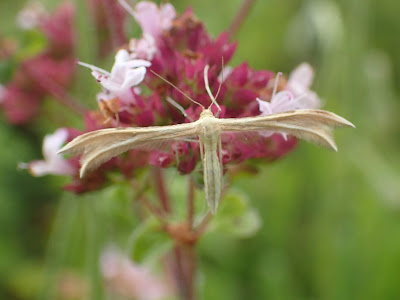Who needs a moth trap when you have a pair of eyes?
Posted by Graeme Lyons , Thursday, 1 August 2019 13:18
Or as I initially called this blog post: Passive sampling vs. active sampling.
I am a big fan of moth-trapping, don't get me wrong. It's a great way of racking up vast numbers of records for a site in a short space of time without leaving the comfort of your home but just how valuable are these records? The moth trap we run at Southerham picks up lots of moths off the chalk but it also gets lots of moths from the nearby Lewes Brooks wetland that are definitely not breeding on site. There was even a Pine Hawk-moth recently and there is very little pine nearby.
I am a big fan of moth-trapping, don't get me wrong. It's a great way of racking up vast numbers of records for a site in a short space of time without leaving the comfort of your home but just how valuable are these records? The moth trap we run at Southerham picks up lots of moths off the chalk but it also gets lots of moths from the nearby Lewes Brooks wetland that are definitely not breeding on site. There was even a Pine Hawk-moth recently and there is very little pine nearby.
When I am doing surveys of invertebrates, I treat moths like any other taxa. You never catch a 100 species in a day, no way near that, but the moths that you get are almost always species that are breeding on a site. In the last month Glenn and I have been carrying out a vegetation survey of Malling Down and I have been constantly distracted by moths during these surveys. Although this site is extremely well recorded, we have added quite a few rare and scarce species.
First is Mecyna flavalis. This pRDB3 species is known really only from Deep Dean in Sussex, I went there with Michael Blencowe to look for it eight years ago and have not seen it since. It occasionally turns up in moth traps but this is the first record in the field of a specimen away from Deep Dean. Frustratingly I did only see one, which is a lot less significant than two, but the habitat was exactly the same. Extremely tightly grazed south facing chalk-grassland. This moth was not here by mistake and I would expect we will see this moth here again soon.
Yesterday we found the smart looking Moitrelia obductella (pRDB3). It would seem that this is the first record in Sussex that wasn't in a moth trap and it was also new to Malling Down.
Also yesterday were two Chalk Carpets (known from the site but I always get an eight-figure grid ref for these as they are on the real S41 list).
And the nationally scarce b Dingy White Plume which is common enough on the Downs where there is Marjoram, also new to the site.
Yet finding larvae in the field is even better. You're guaranteed it's breeding on site if you find larvae. Not rare but Glenn spotted this Small Elephant Hawk-moth in a plot last week, the first I have seen of this species. It really does look a bit like a Grass Snake! It lacks the spine at the back of Elephant Hawk-moth but also the eye spots are more detailed and a bit more like Peacock butterflies eye spots.
I would love to see more people finding larvae and adults in the field. And just so you know you don't need a trap to find rarities, here is a quick reminder of the Purple Marbled I found at Seaford Head a few weeks ago when I didn't even have my net to hand, just a tiny glass tube.
And out of county but last week I found a Vestal in a bog in the middle of nowhere.
And if you target a specific food plant for inverts that only eat that plant then you often turn up the goods. I beat a Crab Apple at asite in Surrey recently and this Argyresthia ivella came off it, the only time I have ever seen this Nb species. What was perhaps more unusual was the bare-footed man who appeared out of nowhere playing the theme tune to Lawrence of Arabia on a flute. I would like you to appear doing this whenever I get a lifer from now on please. It was magical.
And I got a lifer in my own house yesterday morning whilst brushing my teeth. I looked up next to my dried Hops to see a little pyralid I didn't recognise. I had the back door open the night before so it must have come in that way. Or so I thought. On closer inspection it was an Indian Meal Moth Plodia interpunctella (it was neither spicy or filling I should add. Om nom nom). An adventive species, I think I found it right next to its food plant. They must be eating my dried Hops! It's quite a smart little beast though.
So you don't need a moth trap to find rare and unusual moths, but they will probably be mainly micros!

















Post a Comment